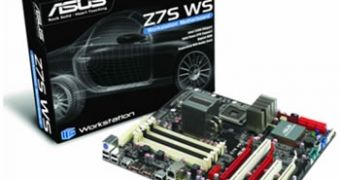Asus has just released its Z7S WS workstation motherboard that comes with two LGA 771 processor sockets. The new motherboard is the base of Intel's recently announced Skulltrail enthusiast platform.
Apart from the two LGA 771 sockets tailored for the latest quad-core chips from Intel, the motherboard packs the latest Intel 5400 chipset, fully buffered DDR2 800MHz dual-channel memory, dual PCI Express 2.0 x16 lanes, all enclosed in a compact CEB form-factor.
The user can easily expand the existing configuration via the multiple slot interfaces available. The motherboard supports dual PCI-Express 2.0 x16 that deliver double data bandwidth (from 2.5 GB/s to 5.0 Gb/s). Moreover, the Z7S WS features PCI-X slots for server-class expansion cards. It is also able to deliver full speeds for Gigabit Ethernet, SCSI RAID and other PCI-X devices.
The new motherboard offering from Asus comes with dual-CPU sockets, 6 FB-DIMMs as well as wide connectivity options. The small-form factor allows users to build a space-efficient workstation, while enjoying the unleashed power of two processors, although professional cooling is critical for the system's performance and stability.
The motherboard supports the dual-core Xeon 5100/5200 and 5300/5400 quad-core processors and comes with two PCI-Express x16 2.0 slots with CrossFire support. Unlike the original Skulltrail, the Z7S WS lacks Nvidia's chips that unleash the power of SLI configurations, so the user is stuck with AMD's graphics cards as the only solution.
The motherboard optionally ships with Asustek's patented MemCool Kit that increases the performance of the fully-buffered DIMM memory modules and eliminates the risk of system being braked by the excessive accumulation of heat.
The motherboard is easy to install and extremely user-friendly. It features the Q-Connector, that allows users connect and disconnect the front panel in a single move, while the Q-Shield protects the motherboard from electrostatic discharges that can be fatal to its semiconductors.

 14 DAY TRIAL //
14 DAY TRIAL //